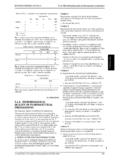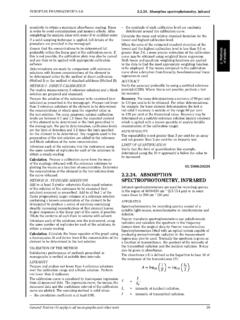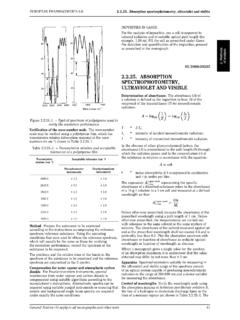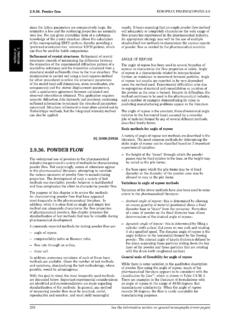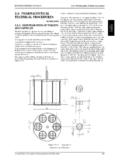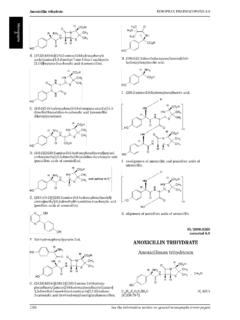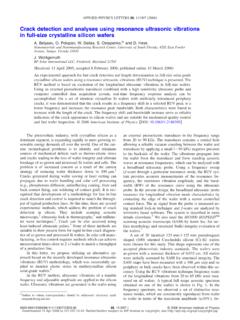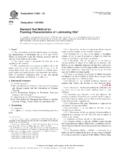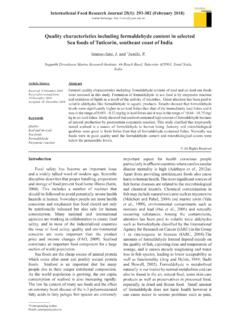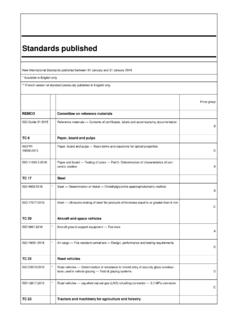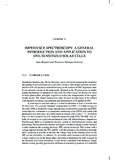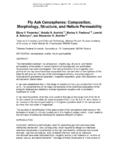Transcription of 2.2. PHYSICAL AND PHYSICOCHEMICAL METHODS
1 EUROPEAN PHARMACOPOEIA Clarity and degree of opalescence of PHYSICAL ANDPHYSICOCHEMICALMETHODS01/2008 CLARITY AND DEGREE OFOPALESCENCE OF LIQUIDSVISUAL METHODU sing identical test-tubes of colourless, transparent, neutralglass with a flat base and an internal diameter of 15-25 mm,compare the liquid to be examined with a referencesuspension freshly prepared as described below, the depthof the layer being 40 mm. Compare the solutions in diffuseddaylight 5 min after preparation of the reference suspension,viewing vertically against a black background. The diffusionof light must be such that reference suspension I canreadily be distinguished fromwater R, and that referencesuspension II can readily be distinguished from referencesuspension its clarity is the same as thatofwater Ror of the solvent used when examined under theconditions described above, or if its opalescence is not morepronounced than that of reference suspension sulphate solution.
2 Dissolve g ofhydrazinesulphate Rinwater Rand dilute to ml with the samesolvent. Allow to stand for 4-6 flask, dissolve g ofhexamethylenetetramine Rin ml ofwater opalescent suspension(formazin suspension).To the hexamethylenetetramine solution in the flask ml of the hydrazine sulphate solution. Mix and allowto stand for 24 h. This suspension is stable for 2 months,provided it is stored in a glass container free from surfacedefects. The suspension must not adhere to the glass andmust be well mixed before of opalescence. Dilute ml of the primaryopalescent suspension to ml withwater is freshly prepared and may be stored for up to24 suspensions.
3 Prepare the reference suspensionsaccording to Table Mix and shake before of opalescence ml ml mlWater ml ml ml mlTurbidity standard. The formazin suspension prepared bymixing equal volumes of the hydrazine sulphate solutionand the hexamethylenetetramine solution is defined as a4000 NTU (nephelometric turbidity units) primary referencestandard. Reference suspensions I, II, III and IV have valuesof 3 NTU, 6 NTU, 18 NTU and 30 NTU respectively. Stabilisedformazin suspensions that can be used to prepare stable,diluted turbidity standards are available commercially andmay be used after comparison with the standards preparedas has several desirable characteristics that make it anexcellent turbidity standard.
4 It can be reproducibly preparedfrom assayed raw materials. The PHYSICAL characteristicsmake it a desirable light-scatter calibration standard. Theformazin polymer consists of chains of different lengths,which fold into random configurations. This results in a wideassay of particle shapes and sizes, which analytically fitsthe possibility of different particle sizes and shapes that arefound in the real samples. Due to formazin s reproducibility,scattering characteristics and traceability, instrumentcalibration algorithms and performance criteria are mostlybased on this METHODSINTRODUCTIONThe degree of opalescence may also be determined byinstrumental measurement of the light absorbed orscattered on account of submicroscopic optical densityinhomogeneities of opalescent solutions and such techniques are nephelometry and turbidity measurement of coloured samples.
5 Ratioturbidimetry and nephelometry with ratio selection are light scattering effect of suspended particles can bemeasured by observation of either the transmitted light(turbidimetry) or the scattered light (nephelometry). Ratioturbidimetry combines the principles of both nephelometryand turbidimetry. Turbidimetry and nephelometry are usefulfor the measurement of slightly opalescent suspensions produced under well-definedconditions must be used. For quantitative measurements,the construction of calibration curves is essential, since therelationship between the optical properties of the suspensionand the concentration of the dispersed phase is at determination of opalescence of coloured liquids isdone with ratio turbidimeters or nephelometers with ratioselection, since colour provides a negative interference,attenuating both incident and scattered light and loweringthe turbidity value.
6 The effect is so great for even moderatelycoloured samples that conventional nephelometers cannotbe instrumental assessmentof clarity and opalescenceprovides a more discriminatory test that does not depend onthe visual acuity of the analyst. Numerical results are moreuseful for quality monitoring and process control, especiallyin stability studies. For example, previous numerical data onstability can be projected to determine whether a given batchof dosage formulation or active pharmaceutical ingredientwill exceed shelf-life limits prior to the expiry a suspension is viewed at right angles to the directionof the incident light, the system appears opalescent due tothe reflection of light from the particles of the suspension(Tyndall effect).
7 A certain portion of the light beam enteringa turbid liquid is transmitted, another portion is absorbedand the remaining portion is scattered by the suspendedparticles. If measurement is made at 90 to the light beam,the light scattered by the suspended particles can be usedfor the determination of their concentration, provided thenumber and size of particles influencing the scatteringremain constant. The reference suspension must maintain aconstant degree of turbidity and the sample and referencesuspensions must be prepared under identical Tyndall effect depends upon both the number ofparticles and their size. Nephelometric measurements aremore reliable in low turbidity ranges, where there is a linearrelationship between nephelometric turbidity unit (NTU)values and relative detector signals.
8 As the degree ofturbidity increases, not all the particles are exposed to theincident light and the scattered radiation of other particlesis hindered on its way to the detector. The maximumnephelometric values at which reliable measurements can beGeneralNotices(1) Degree of coloration of liquidsEUROPEAN PHARMACOPOEIA lie in the range of 1750-2000 NTU. Linearity must bedemonstrated by constructing a calibration curve using atleast 4 optical property expressed as turbidity is the interactionbetween light and suspended particles in liquid. This is anexpression of the optical property that causes light to bescattered and absorbed rather than transmitted in a straightline through the sample.
9 The quantity of solid material insuspension can be determined by the measurement of thetransmitted light. A linear relationship between turbidityand concentration is obtained when the particle sizes areuniform and homogeneous in the suspension. This is trueonly in very dilute suspensions containing small between turbidity and concentration must beestablished by constructing a calibration curve using at TURBIDIMETRYIn ratio turbidimetry the relationship of the transmissionmeasurement to the 90 scattered light measurement isdetermined. This procedure compensates for the light thatis diminished by the colour of the sample.
10 The influenceof the colour of the sample may also be eliminated byusing an infrared light-emitting diode (IR LED) at 860 sphotodiode detectors receive and measure scattered lightat a 90 angle from the sample as well as measuring theforward scatter (light reflected) in front of the sample alongwith the measurement of light transmitted directly (ratio)and are obtained by calculating the ratio of the 90 anglescattered light measured to the sum of the components offorward scattered and transmitted light values. In ratioturbidimetry the influence of stray light becomes are used for measurements of the degree ofopalescence of colourless of reference suspensions I-IV with a ratioturbidimeter show a linear relationship between theconcentrations and measured NTU values.



